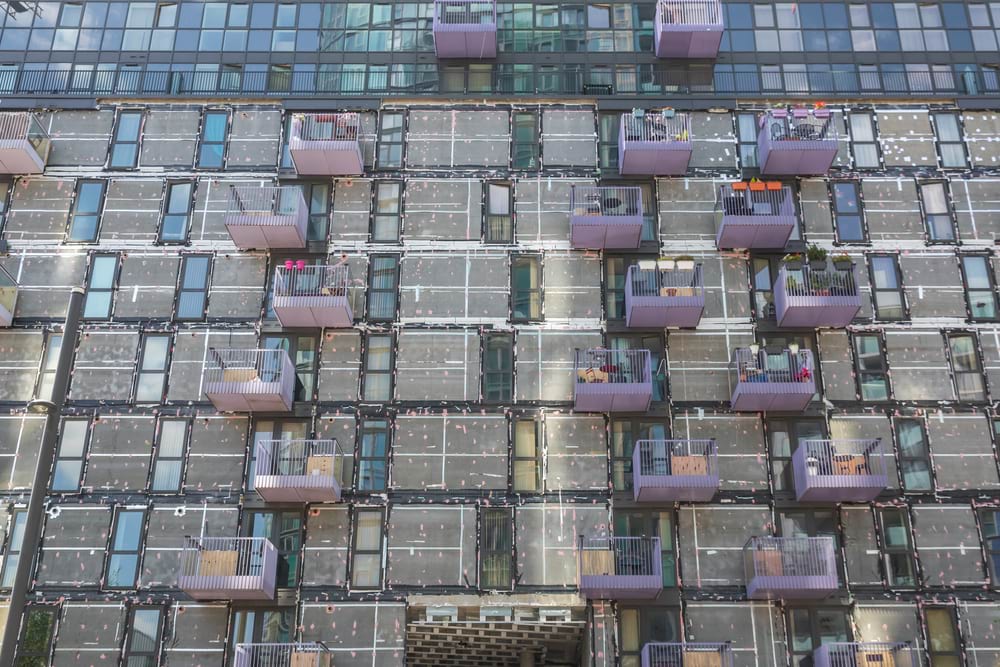Selling a flat with cladding can be difficult.
Like asbestos, it is common across Britain but increasingly regulated.
But what is cladding? Why was it used? And how much of a threat to safety is it?
Read on to learn more.
What is cladding in construction?
Cladding is a non-structural and non-loadbearing (i.e., it doesn’t support any weight) surface added to the exterior of buildings.
It protects them from natural elements (wind, rain, frost, and sunlight) and adds insulation.
Cladding is usually installed during construction. But it can also be added later on.
It is mainly added to blocks of flats and commercial buildings. Some houses have it, but most don’t.
The type of claddings buildings have in-part depends on when they were built. New buildings generally have safer and more efficient materials due to regulation.
Is cladding a legal requirement?
Cladding is not a legal requirement for all buildings but most blocks of flats and commercial buildings have it.
Regulation on what materials can be used for it is mandatory for all high-risk buildings (HRB) buildings.
The threshold for this category was previously set at higher than 18 metres, but in 2022 this was amended to higher than 11 meters.
For buildings below 11 metres, the regulations for cladding are slightly looser.
Grenfell Tower Fire
In June 2017, a fire broke out in Grenfell Tower, a 24-storey block of flats in North Kensington, London.
It burned for 60 hours and claimed the lives of 72 residents. Combustible foam cladding was found to be a leading cause of the fire’s destruction.
After this, stricter laws were enacted to address the issue of unsafe cladding.
Different types of cladding
Wood
Wood is commonly used as a cladding material. It is often referred to as ‘timber cladding’.
(This is not the same thing as a timber-framed building.)
It can give an attractive, modern appearance to buildings. It’s also one of the less expensive materials to use.
Stone
Stone is durable over long periods. It’s relatively expensive and difficult to work, so it tends to be used on higher-end, more expensive developments.
Bricks
Bricks are a popular material for cladding because of their relatively low cost and pleasant aesthetic appearance.
Metal
Metal cladding is one of the most popular types in the UK. You’ll often see this on high-rise residential and commercial buildings.
It’s arguably one of the most cost-effective solutions while meeting all regulatory requirements.
Concrete
Concrete is a common choice for cladding it is relatively durable and highly thermal.
It comes in many forms. Fiber-reinforced concrete (FRC) is one of them – it is relatively fire-resistant and flexible.
Vinyl
Vinyl is versatile. It comes in many different shapes and colours and is relatively low-cost and durable.
However, it is not as environmentally friendly as other materials or as aesthetically pleasing.
uPVC
uPVC is a low-maintenance solution, often used in smaller residential properties.
How much does cladding cost?
Cladding is usually priced per square metre.
Around £100 per square metre is a typical figure. This can bring your price to around £5,000 in total for smaller residential properties.
But for a large high-rise block of flats, around £25,000 is typical.
Don’t forget that your price will vary based on several factors. Some materials are far more expensive than others.
And the shape and colour will impact cost, too.
Don’t forget that every building contractor has different pricing levels. So, you should get several quotations and compare.
Even if cladding is expensive, you must meet all your regulatory requirements.
How long does cladding take to install?
In most cases, cladding takes a couple of weeks to install. This timeframe is shorter for smaller residential properties.
However, building the largest blocks of flats or skyscrapers in major cities can take up to a month.
You should get a quotation from your contractor at the expected time. You can usually continue to live in there while cladding is added.
Similarly, re-cladding buildings can take months of work.
Can tenants complain if their building doesn’t have cladding?
It depends. Tenants or flat owners can complain if their landlord or freeholder is not meeting their regulatory requirements.
For example, if they live in a building taller than 11 metres with combustible cladding, they should report it immediately.
Ideally, they will bring it up to their landlord or freeholder, who will fix it right away.
But if they feel this isn’t happening, their local council is often the best organisation to report this to.
Tenants may also want to ask a building surveyor or a fire safety expert for an independent opinion.
Can property owners be forced to add cladding to my property if I don’t want to?
In some cases, building owners can be forced to add cladding. And if the building’s cladding doesn’t comply with fire safety regulations, their local council can force them to change it.
Flat owners could also be forced to do this if they live in a building with shared ownership. Especially if most people vote for cladding installation on the whole structure.
In other scenarios, property owners can’t be forced to put it in if you aren’t breaking any regulations.
Indeed, in rare situations in a protected area, a homeowner might be forced to remove the cladding or at least change it.
This is if the local council determines it isn’t conducive to the area’s aesthetic.
Does cladding impact property value?
Yes, cladding can have a major effect on house value.
This may go in either direction, depending on the circumstances.
Most people view cladding as a good thing. This is because it protects your building from damage.
But people only take this view if the cladding is aesthetically pleasing and made from non-combustible materials. Potential buyers will usually want to check this.
On the other hand, cladding can decrease property value if it’s poorly installed.
This could be because it’s made from combustible materials.
Or maybe it simply looks very unattractive. If there’s an ongoing dispute about the cladding on your house, this can reduce property value, too.










